No products in the cart.
July 16, 2025
Joan Mitchell’s work is fierce and expansive. Her colours scream; they swirl, they flow across the canvas. There is a power in her paintings that is not nice. No decorum, no compromise.
Just colour, surface. Urgency.
She was not a stylistic revolutionary. Joan Mitchell did not reinvent the vocabulary of Abstract Expressionism, but she appropriated it in a very personal, emotional and often physically tangible way. Her paintings became spaces of inner perception. Nature was never merely a template, but an impulse: she did not paint landscapes, but the feeling of moving within them. She herself called it ‘remembered landscapes’.
Women have always had a hard time in the art world. They were ridiculed, marginalised, and after their death their achievements were often attributed to male colleagues. But in abstract art, the invisibilisation of female artists was systematic.
Abstract Expressionism in the USA of the 1940s and 60s was literally charged with a macho artist figure: large-format painting, physical, impulsive - this was seen as an expression of power and authenticity - and thus as masculine, although female artists also worked with vigour and gesture.
Women like Grace Hartigan, Elaine de Kooning or Helen Frankenthaler were often only visible when they were in a relationship with famous men: as a wife, muse, pupil or lover. Even Lee Krasner, a highly interesting artist, often remained ‘the wife of’ during her lifetime - in her case Jackson Pollock.
Joan Mitchell was one of the few women to hold her own in the male-dominated field of Abstract Expressionism. And she didn't do it quietly! Her works became larger, her colours bolder, her expression more uncompromising. And yet, she remained in the shadow of her male colleagues for a long time.
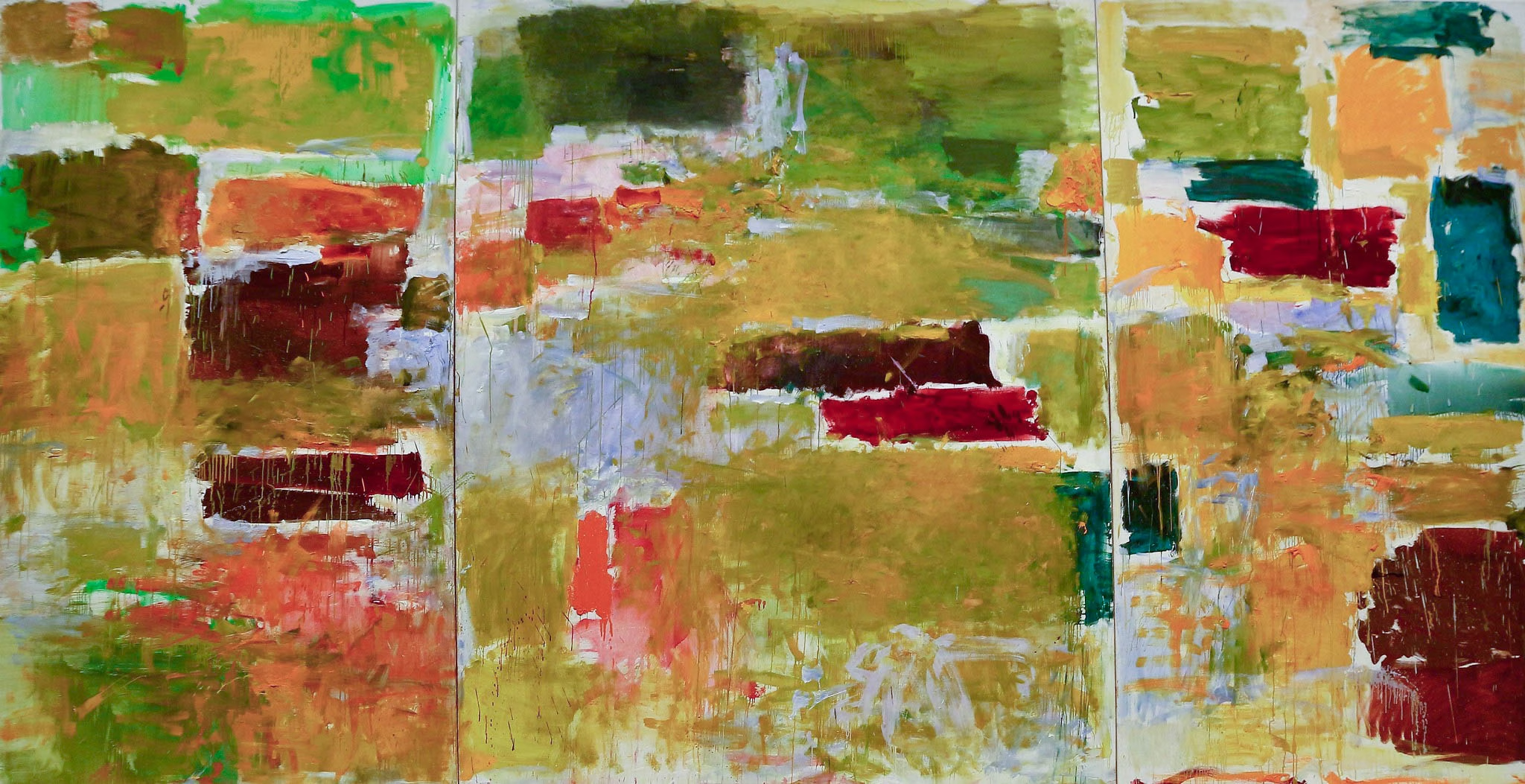
Joan Mitchell, Plowed Field, 1971
Joan Mitchell was never particularly interested in being perceived as a female artist. She is even said to have once said: ‘I'm not a woman, I'm a painter’. Perhaps a little irritating from today's perspective. But what appears to be a defence against feminist attributions was actually an attempt to escape the labels of the art world at the time.
She did not want to be reduced to being a woman, to be seen as an exception or a special case - but as a serious artist. Full stop. She was aware that she still had to assert herself in a field dominated by men.
Her painting style was often described by critics as ‘masculine’. This was meant as a compliment. As if only ‘male energy’ could produce physical power. Power was seen as masculine, emotion as feminine - and both together? It wasn't meant to be like that.
Mitchell broke this mould with every brushstroke.
Her father, a renowned doctor and amateur painter, had wanted a son, and he took out his disappointment on his daughter. It is even said that Mitchell was initially named 'John' on her birth certificate. Nowadays, this would be seen as an attempt to challenge binary gender roles. But back then, the message was clear: you will never fulfil my expectations.
Charles Mitchell was seen as rather cool and performance-oriented; he expected results, discipline and seriousness. The relationship between father and daughter remained distant throughout his life. Although he was a patron of the arts, he supported them more because it was part of his social position than out of passion.
Her mother, Marion Strobel, was a published poet and the editor of Poetry Magazine, as well as being a close friend of T. S. Eliot and Ezra Pound. She encouraged Joan to be creative, but not without expectations. In Joan Mitchell's upper-middle-class academic home in Chicago during the 1920s and '30s, creativity was probably more a cultural ideal of education. It was not authentic self-expression, but rather a sign of social standing, taste, and distinction.
So Joan grew up in an environment that valued literature and art, and which was characterised by high standards. She began drawing at an early age and loved poetry. She also excelled at sport as a child — she was a talented figure skater and won several prizes in show jumping as a teenager. However, the focus was always on performance.
She began studying art at the age of 19. This classical education brought her into contact with both figurative painting and modern theory. After completing her Bachelor of Fine Arts (BFA) and Master of Fine Arts (MFA) degrees at the Art Institute of Chicago, she moved to New York to study art history at Columbia University. She also studied French at New York University.
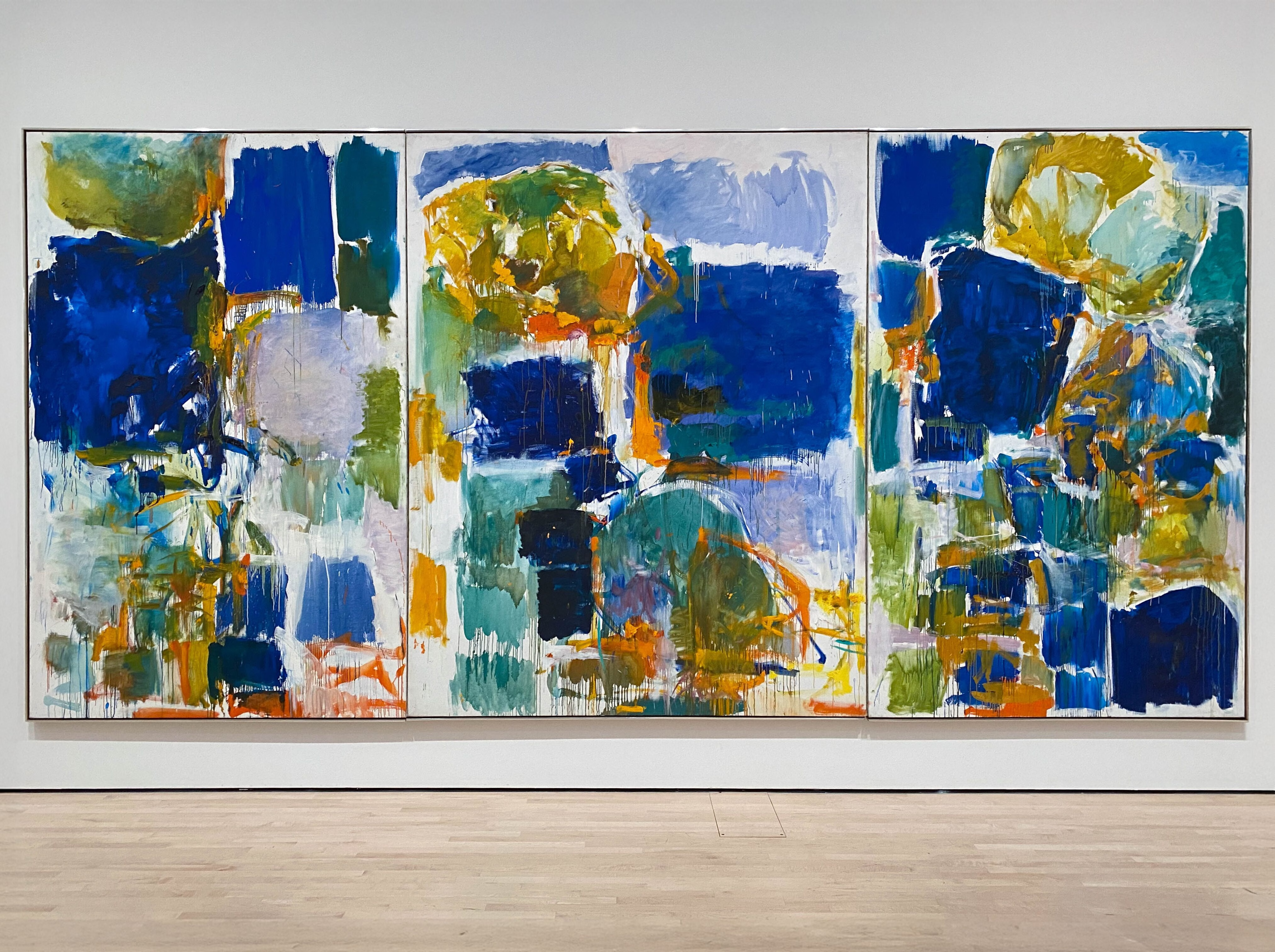
Joan Mitchell, Bonjour Julie, 1971
During this time, she increasingly began to move away from figurative art. Artists such as Cézanne, van Gogh and Matisse in particular characterised her view of painting. In them, she found what she herself was looking for: composition as expression, colour as emotion, landscape as remembrance.
As early as the 1950s, New York was a centre of artistic awakening, but also a shark tank. Mitchell asserted herself with raw wit, a self-confident demeanour and a style of painting that was neither tame nor hesitant. She was part of the legendary Cedar Bar circle, drank with de Kooning, debated with Franz Kline and was soon invited to the same galleries as her male colleagues.
In 1955, she had her first solo exhibition at the Stable Gallery in New York. Her work quickly attracted international attention. But New York was also a place of noise, competition and excess. Perhaps this is why Joan Mitchell regularly travelled between New York and Paris.
In the summer of 1955, she met the Canadian painter Jean-Paul Riopelle at a party there. A stormy, creatively intense and often turbulent relationship began. By the end of 1959, the couple moved into a shared studio apartment on Rue Frémicourt in the 15th arrondissement. An open-plan space, ideal for working on large-format paintings. They lived, worked and discussed there.
Their work influenced each other, but their relationship was also characterised by fights, alcohol, jealousy, and infidelity. In 1978, Riopelles' affair with Mitchell's assistant Hollis Jeffcoat ended their more than 20 years together. Joan Mitchell dealt with the break-up in her work La vie en rose.
In 1968, she bought a property in Vétheuil, about 70 kilometres north-west of Paris, not far from the house where Claude Monet had lived for several years before moving to Giverny. She lived there with her dogs, her paints and her canvases.
Mitchell's estate was situated on a hill above the town, with a sweeping view of the Seine. The French landscape became the emotional backdrop to her paintings.
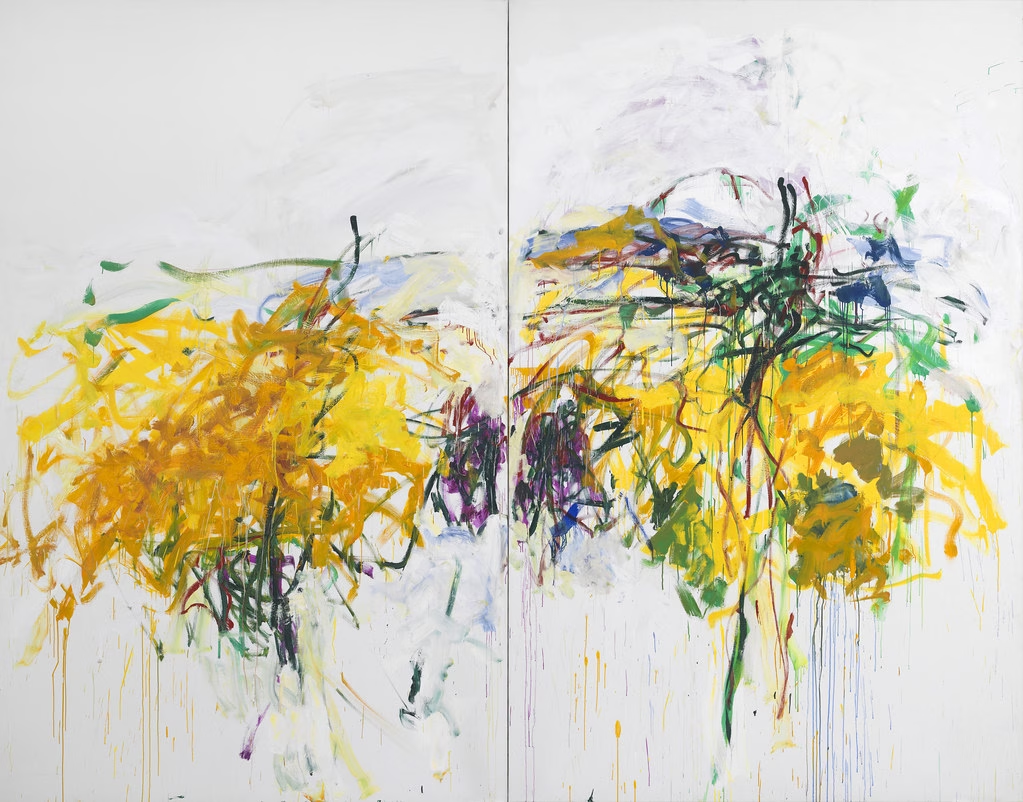
Joan Mitchell, Sunflowers, 1990
"Sunflowers are something I feel very intensely. They look so wonderful when young and they are so very moving when they are dying. I don’t like fields of sunflowers. I like them alone or, of course, painted by Van Gogh."
- Joan Mitchell
Surrounded by trees, water and vast skies, Joan Mitchell found the freedom that she could never quite achieve in New York. In Vétheuil, her art became larger, more complex, more determined and more fragile at the same time.
The representational did not disappear, it was merely transformed: into rhythm, colour, surface. Mitchell was not a purely abstract painter in the classical sense. Her works often remained anchored in real experiences, but without depicting them. ‘My paintings only get their titles when they are finished,’ she said. ‘I paint according to the landscapes I remember and the feelings I carry with me.’
And so her works are sometimes suffused with light, sometimes drenched in pain.
For her, colour was a means of making the inexpressible visible. She spoke in colours, like others in tones or verse. She herself admired Charlie Parker and Miles Davis, but also Beethoven. Her brushstrokes often seem like improvisation, like jazz: full of energy, wild and rough.
Literature also played a major role. Mitchell read Proust and T. S. Eliot, again and again. Proust's idea of ‘mémoire involontaire’ - involuntary memory - is reflected in her paintings. It is not about a motif, but about the emotions she leaves behind. Or as she herself said: "I could never mirror nature. I would rather paint what it leaves behind in me."
The titles of her works are often quietly telling: La Grande Vallée, No Rain, Ladybug, Sunflowers. Nature dives, fragments of memories, delicate observations. La Grande Vallée, for example - a monumental series of around twenty works - was created in 1983/84 when Joan Mitchell's close friend Gisèle Barreau lost her cousin in 1982. She spoke of her memories of a hidden valley in Brittany, wild and flooded with light. A place of childhood, life and loss. She wished she could travel with him to that place again.
Mitchell had never been to Brittany, but she too had suffered a great loss. Her sister also died in 1982, and Mitchell later said she had wanted to paint an imaginary place, a place she would have liked to visit. In the series, green, blue, bright yellow and earthy tones flow into one another - powerful, stormy, vulnerable and full of longing. The painted meadows and bushes are metaphorically charged, touching on the remembered, the lost and the lasting.
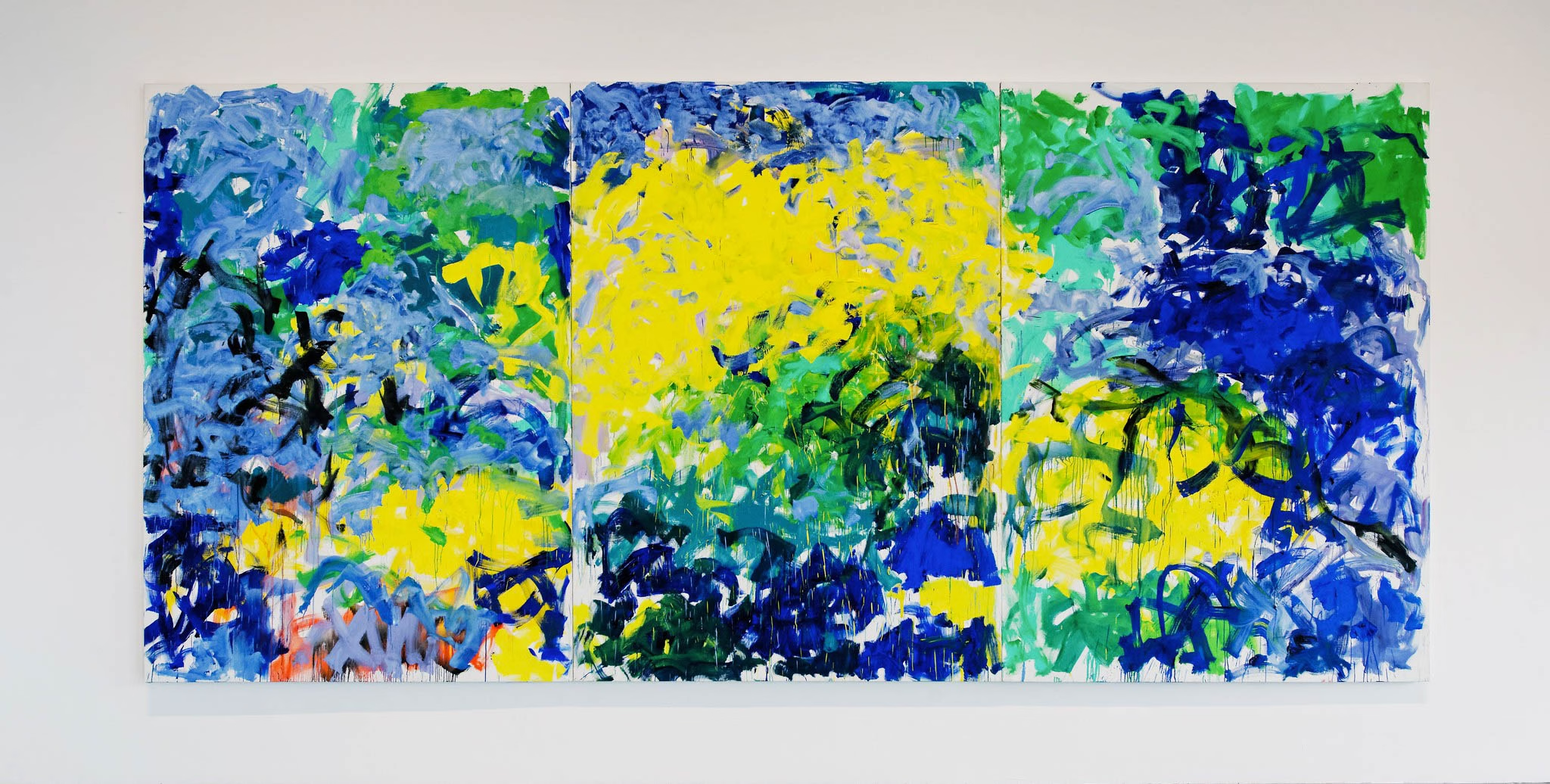
Joan Mitchell, La Grande Vallée XIV (For a Little While), 1983, Öl auf Leinwand
Joan Mitchell always worked with what was there. Even when it hurt. She did not instrumentalise the pain. She didn't suppress it either, but worked with it.
There were many goodbyes in her life. The loss of her mother in 1966, with whom she had a complicated but deeply formative relationship, and the death of her father just four years earlier. The break-up with Jean-Paul, with whom she had been linked for more than two decades. And finally, the death of her sister from cancer, which shook her to the core. Mitchell rarely spoke publicly about her grief. But her paintings became denser and more emotionally charged during these years. With dense, cracked brushwork, in demanding colours, in forms that sought support.
Her alcohol consumption was well known. Friends, gallery owners and colleagues talked about it, and it was part of her public demeanour: loud, direct, sarcastic - often with a glass in her hand. Quite the drinking, ranting, excessive artist. Her assistant and later biographer Patricia Albers describes her alcohol consumption as part of Mitchell's self-image as a non-conformist, resistant woman.
But even after a night of drinking, Joan Mitchell worked with discipline in her studio the next morning.
She was diagnosed with cancer in the mid-1980s. Mitchell underwent operations, later radiotherapy, and in the meantime lost her physical strength. But she did not stop painting. Her paintings remained powerful - but now often interspersed with white spaces. They showed her unbroken desire for expanse and movement.
Joan Mitchell died in Paris in 1992. Her last works seem to have the opposite of farewell in mind: Presence. Life. Colour.
In public, she was long regarded as 'the one who drank with the boys', a talented outsider among the heroic male painters. It took a while for her own voice to be heard. In the 1980s, the field of feminist art history gained momentum and began to re-evaluate women artists who had previously been overlooked or marginalised. In this context, Mitchell's work was considered to exist beyond purely stylistic categorisation, representing an independent artistic position.
After her death, major retrospectives such as the one in 2002: Joan Mitchell: The Paintings at the Whitney Museum, and Joan Mitchell at the San Francisco MoMA (later also shown in Baltimore and Paris), played a significant role in repositioning her influence. She is no longer considered a marginal figure, but rather a central artistic counterpart to her male colleagues. The art market has long since followed suit. Her works now fetch millions.
In 1993, one year after her death, the Joan Mitchell Foundation was established. Shortly before her death in Paris, she stipulated in her will that she wanted not only to preserve her work, but also to support living artists, especially those in difficult circumstances.
The Foundation is dedicated to creating a comprehensive catalogue raisonné, as well as archiving Mitchell's letters, sketchbooks, and correspondence. It is committed to diversity, visibility, and fair promotion. The Foundation awards grants and emergency aid, particularly for painting and sculpture.
Although Mitchell herself was never 'pedagogically' active, she believed in artistic freedom and expression, as well as the value of time and space in which to work. Through the Joan Mitchell Center in New Orleans, the Foundation offers residency programmes that provide a place for artistic exchange, rest and production.
Joan Mitchell's influence is more atmospheric than stylistic. Her attitude, painterly independence and handling of emotion and colour were inspiring. Many contemporary artists regard Mitchell as a trailblazer.
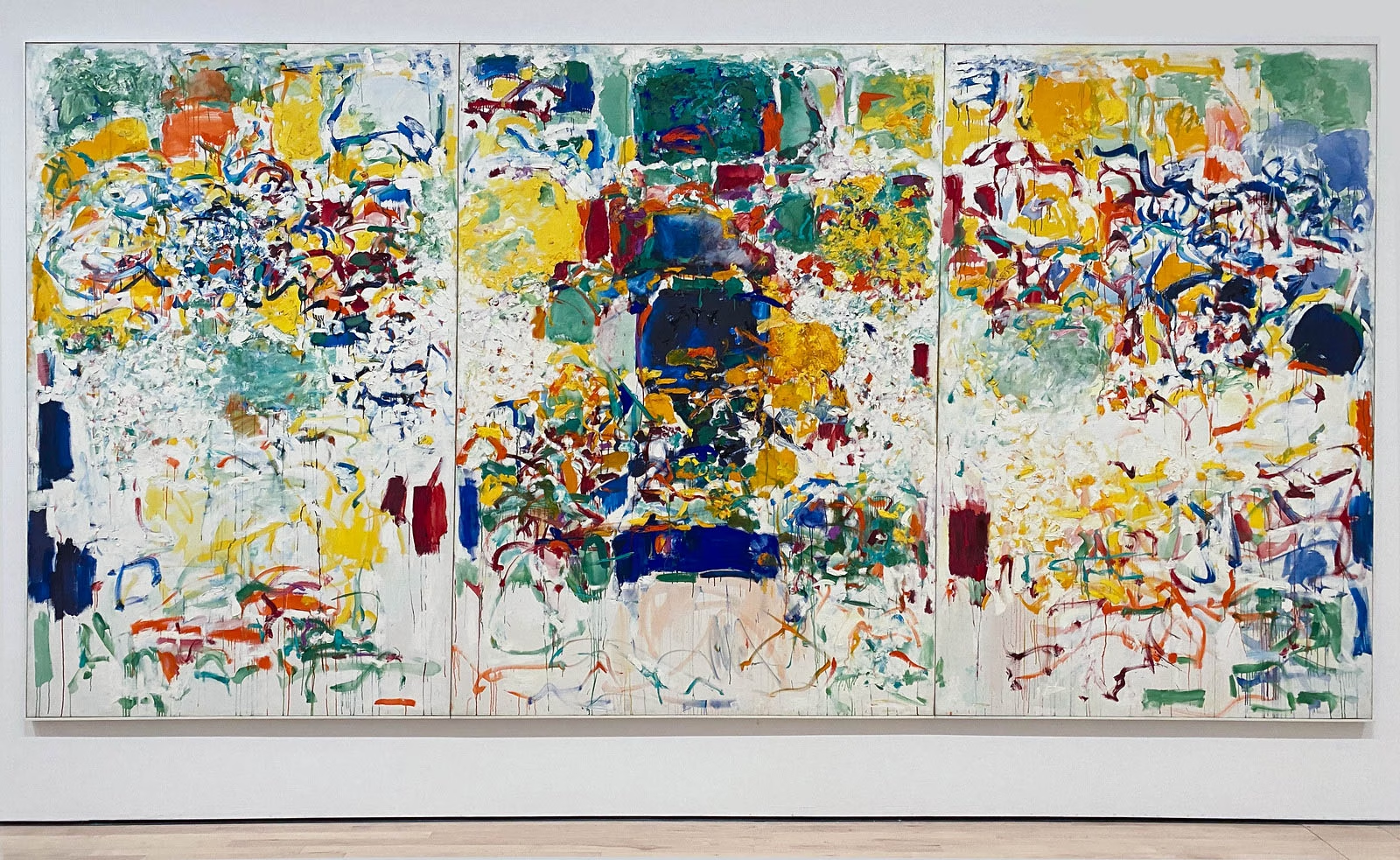
Joan Mitchell, Sans Niege, 1969
Broken lines and resistant surfaces. Even in pictures on the internet, the emotional tension and pull of Mitchell's works can be felt. However, this pales in comparison to the almost physical experience of standing in front of one of her monumental pieces. Their enormous size and vibrant colours can literally overwhelm you.
Unfortunately, this is a rare opportunity in Europe. If you are not fortunate enough to visit a retrospective — which is not even possible this year, the centenary of her birth — you must travel to Venice (Peggy Guggenheim Collection), Paris (Foundation Louis Vuitton or, after its planned reopening in 2030, the Centre Pompidou) or, more recently, London (Tate Modern).
Perhaps it's because she was a woman. Or perhaps it's because she was American. But Europe needs these huge colour spaces too.
Have you ever seen one of Joan Mitchell's paintings in person? Which one and where?
Join the newsletter now
and not miss a thing
Get exclusive insights into my creative processes, learn the stories behind my artwork
and receive invitations to my exhibitions and events.
To say thank you, I'll give you 10% off your first purchase.